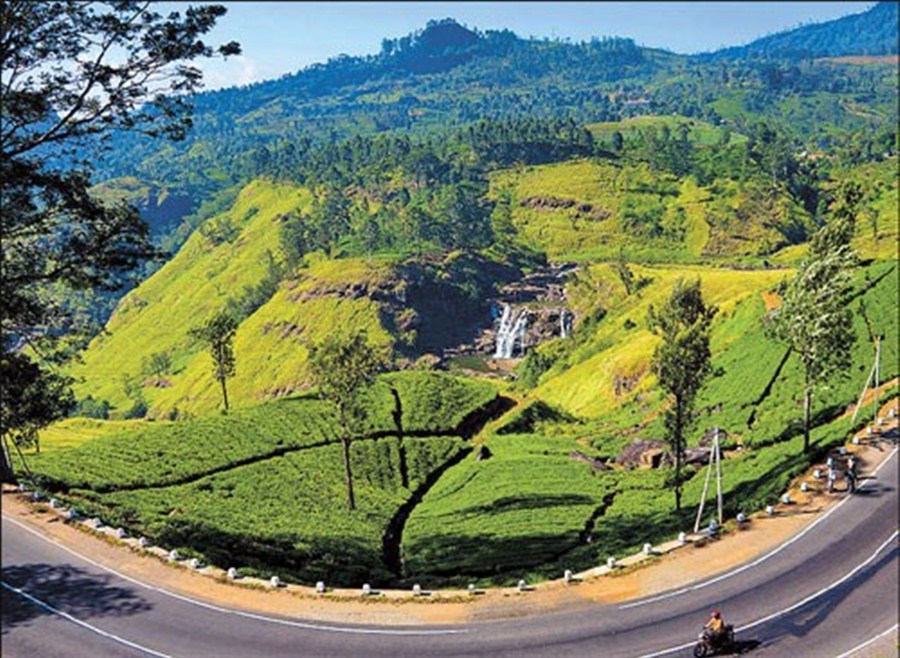
Wednesday, 15th July 2015
By Zhou Yubin and Tong Wangyue

A tea plantation in Nuwara Eliya — Yang Xisheng
BEFORE our trip to Sri Lanka, a friend told us that the country enjoys a reputation as a “combination of India, Kenya and the Maldives.” It has India’s Buddhist culture, Kenya’s wild animal safaris and Maldives beaches.
We haven’t been to any of those three countries, but we did spend five days in Sri Lanka and found no end of diversity to please any visitor.
You can drive from tranquil beaches into lush mountains, visit a Hindu temple just five minutes’ walk from a magnificent Catholic church, and enjoy a safari and a game of golf on the same day.
The island nation isn’t called the “pearl of the Indian Ocean” for nothing.
What is perhaps even more inviting than all the sights and activities is the genuine warmth of the Sri Lankans. Wherever we went, we were greeted by smiling faces.
The most important tip to bear in mind while traveling in Sri Lanka is to avoid trying to cram too much into one day. Don’t rush from one place to another. Taking things slowly gives one the time to enjoying the country’s natural beauty and meet the locals.
Colombo
Colombo is the biggest city and capital of Sri Lanka. For most tourists flying in, it is the first stop. Located on the west coast of the island, Colombo is a vibrant and modern city with shopping malls, five-star hotels and beautiful colonial structures. Just 15 minutes’ drive from downtown are some stunning beaches. Watch where you stand. A railway line runs along the beachfront.
The National Museum of Colombo, also known as the Sri Lanka National Museum, is the biggest museum in the country and the best place to learn about its history. Its white building reminds visitors of a typical British mansion. It was established in 1877 by Sir William Henry Gregory, then British governor of Ceylon. National relics dating back to pre-historic times, Buddhism murals and gifts from Chinese emperors acknowledging Sri Lanka position on the Maritime Silk Road are among the most worthy exhibits.
With tired feet from all the museum walking, it’s relaxing to enjoy a picnic in nearby Viharamahadevi Park, formerly known as Victoria Park. It is also the perfect place for people-watching. On weekends, the park hosts an open-air art gallery, with local artists showing off their work to potential buyers.
Another cultural scenic spot is the Gangaramaya Temple, which is the most important temple in Colombo. It’s usually packed with worshippers during the day. To observe local courtesy, buy some lotus flowers in front of the temple and place them on the alter to show your respect to Buddha.
The temple’s architecture has influences of Sri Lankan, Thai, Indian and even Chinese styles. It contains many surprising items donated by people over the years, including Chinese porcelain, a cabinet full of antique watches, century-old printing machines, an antique car and a large collection of ivory figures and statues of Chinese Taoist gods.
As we were leaving the temple, a few local people drove up in brand new cars and asked the monks to bless them in the name of Buddha.
Elephant orphanage
Located northwest of the town of Kegella, the Pinnawala Elephant Orphanage is a nursery and breeding place for wild elephants. The orphanage has the largest herd of captive elephants in the world. It was originally founded in 1975 by the Sri Lanka Department of Wildlife Conservation to offer protection and care to orphaned wild elephants.
From 10am to 2pm, the elephants are led to a river opposite the orphanage. After taking a shower and drinking some water, they return to their park-like home. Visitors are urged to refrain from teasing or provoking the animals.
Local Sri Lankan food such as curry is available at some riverside restaurants. The food is always spicy but definitely tasty.
Sigiriya
Sigiriya is built on a gigantic orange rock that rises 200 meters from the ground. It is a UNESCO listed World Heritage Site.
According to ancient Sri Lankan chronicles, King Kasyapa (AD 477-495) ordered his palace to be built on top of the rock to provide defense. The rock was later decorated with colorful frescoes.
At the foot of the rock, gardens flank the main pathway. They are among the world’s oldest landscaped gardens and are divided into three forms: water, cave and stones.
A climb up the spiral stairs brings you face-to-face with ancient frescoes that are among the most magnificent in South Asia. The western face of the rock is covered by paintings of beautiful female figures whose true identities still remain a mystery.
Going downstairs, you can walk alongside the famous Mirror Wall, which is highly polished and now bears verses written by former visitors.
Halfway up to the top of the rock is a lion gateway that was carved to demonstrate the king’s unparalleled power. Nowadays, only the paws remain. Beware the upper reaches of the rock. It’s a favorite home for wasps.
This rock is so popular that it’s not uncommon to find queues of visitors waiting to climb it. But the wait is well worth it. The views from the top are simply magnificent.
Temple of the Tooth Relic
Kandy is the second-largest city, located in the middle of the island amid the cool highlands of the Kandy plateau. It is a welcome respite from the lowlands in hot weather.
Kandy’s signature scenic site is the Temple of the Tooth Relic, the most sacred Buddhism temple in the country. The city of Kandy is a UNESCO World Heritage Site, thanks to this temple. It enshrines the venerated Gautama Buddha’s tooth relic, smuggled to the island by Princess Hemamali and her husband Prince Dantha.
Every year in July and August, the festival of Kandy Esala Perahera is held to pay homage to the tooth relic. The procession attracts almost everyone in the city and numerous visitors from all over the world. During the grand festival, traditional local dances are performed. A sacred elephant, adorned in lavish garments, carries the casket of the tooth relic through the streets of Kandy, which are lined with worshippers. It used to be a ritual for the King to pray for good weather, but today it’s a religious as well as a tourism festival.
Not far from the temple are the former Royal Palace and Kandy Lake, which are also worth visiting.
Nuwara Eliya
After spending several days on the hot beach strip of Sri Lanka, a trip to Nuwara Eliya is a welcome respite. We were greeted there by fresh, cool mountain air, picturesque landscapes and Sri Lanka’s most famous export: black tea. Located at an altitude of 1,868 meters and overshadowed by Pidurutalagala, the tallest mountain in the country, this city is the heartland of Sri Lankan tea production.
A visit to any of the many tea plantations will give visitors the opportunity to learn how tea is grown and how leaves are picked, processed and packaged for the Queen’s afternoon tea table. You can also sample various teas before deciding which you might want to buy and take home.
The city of Nuwara Eliya is called “Little England.” It was founded by the British in the 19th century. Most of the hotels in town hark to the nostalgia of the colonial era.
This is a great place to play a round of golf or just hike through quiet landscape. It is also the base for visiting Horton Plains National Park, which features the “World’s End,” a sheer precipice that drops 1,500 meters. It is also famous for its wild safari tours.
Galle
Galle, a harbor city 119 kilometers from Colombo, is also a landmark of Sri Lanka’s colonial past.
It was originally built in 1588 by the Portuguese, and then renovated and fortified by the Dutch in the 17th century. The fort, today a World Heritage Site, is located on the southwest corner of Sri Lanka on a small, rocky peninsula that juts into the sea.
Walking on top of the fort’s seawall gives visitors a spectacular view of the Indian Ocean. Inside the fort are modern foreign boutique shops and restaurants that seem to clash with the exterior environment that make the area look modern and international.




